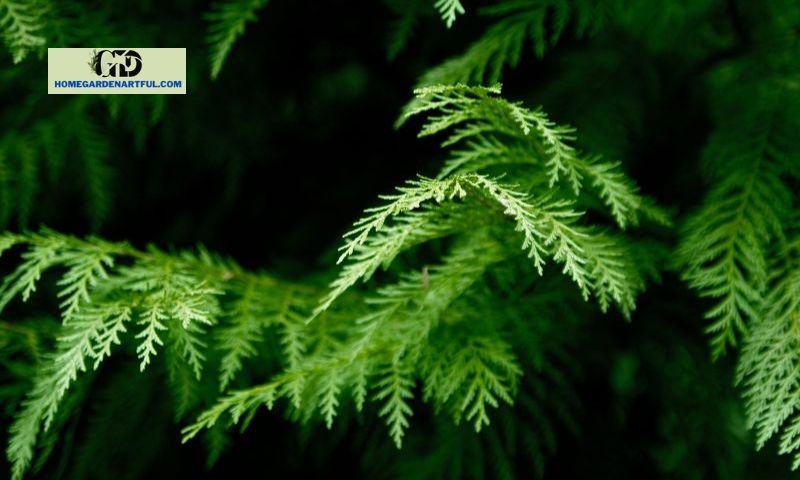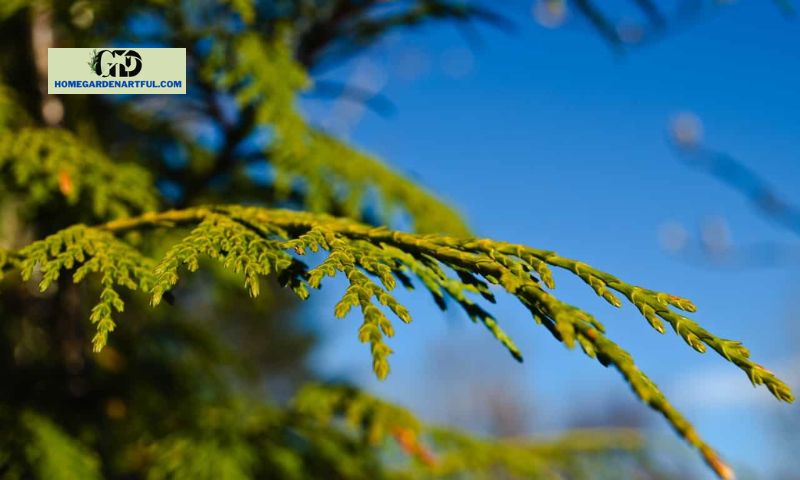Have questions about what to plant as your next evergreen tree? A Weeping Alaskan Cedar may be nice. Even if its “weeping nature” may not quite be the sunshine tree you were searching for, you can at least come to adore it for its charm.
One is even simple to grow! Want to know more?
Homegardenartful.com will get into the specifics of its advantages, dangers, growth circumstances, and how to take good care of it.
What Makes the Weeping Alaskan Cedar So Special?

The Weeping Cypress, also known as Chamaecyparis nootkatensis, has a thousand-year lifespan.
There are several other names for the Alaskan weeping cypress, including Nootka cypress, yellow cypress, Alaska cedar, and Nootka fake cypress.
The genus name of a weeping cypress has been altered from Chamaecyparis nootkatensis to Xanthocyparis nootkatensis since it is more closely related to cypresses than cedars.
The soft, feathery flat-needled boughs and bluish-green leaves are what we adore the most because there are no spiky needles to worry about.
Even with little or no space, the Alaskan cedar is a perfect landscaping plant to have in your garden or front yard because of its pyramidal shape and weeping nature!
Not to mention that the blossoms and bluish-green evergreen leaves add a lovely touch to the scenery.
Risks to Consider
We wouldn’t say there is a significant risk associated with Alaskan cedar. It is, after all, largely pest-resistant!
But occasionally and based on experience, you’ll notice bagworms clinging to its branches. The spruce mites were our biggest concern because, at some point, they can be difficult to eradicate.
This problem is readily remedied by including lots of flowering plants or by applying specific sprays in your garden or other space.
Planting it close to roads is another problem to be aware of. Although it can tolerate some roadside pollution, it is preferable to keep it away from sidewalks, driveways, and general roads.
We wouldn’t want all the careful loving care you put into cultivating this tree to go to waste, so please avoid using road salt throughout the winter.
To completely shield your tree from harm, apply an ice melter that is safe for plants and animals.
The advantages of planting an Alaskan cedar outweigh the hazards by a wide margin.
Varieties of the Weeping Alaskan Cedar Tree

The most prevalent species of weeping Alaskan cedar tree in the United States, Chamaecyparis nootkatensis pendula, may reach heights of 35 feet and a spread of 12 feet. Some types’ branches will touch the ground, enhancing its elegance and aesthetic appeal.
The ‘green arrow’ type of Chamaecyparis nootkatensis is the ideal option if you prefer a smaller tree that can easily fit into a small garden area or yard. Its distinguishing feature is its extremely tiny spire, which can reach heights of 20 feet and a width of 2 feet. Your garden and landscape will benefit from the strong vertical accent created by this compact design.
It is understandable why people have grown to adore this tree given its thousand-year lifespan and graceful appearance.
How to grow Weeping Alaskan Cedar

Planting Location
If you choose to plant an Alaskan cedar tree, pay attention to its broad, beautiful branches because adequate space between each plant is essential.
Why not display its bluish-green foliage and leaves? It would be inappropriate to group these plants together. Many people enjoy seeing their tree’s flowers, especially when it’s in the middle of the day.
Pick a location where every tree will get all-day-long access to the sun. The optimal growing conditions for these trees are partial to full light and moist soil.
You want your soil to be moist because you don’t want it to be soggy. The worst situation for it to be in is standing water.
This would be the ideal environment for its growth if you had a low-lying area or landscape.
Now comes the challenging part.
The weakness of Alaskan cedars is severe winds, notwithstanding their resistance to cold. If you select a location that may experience chilly, blustery winter winds, make sure to protect it beforehand because the winds may dry out branches or needles.
Zones of Hardiness & Growing Conditions
Its development depends just as much on taking hardiness zones into account. Its native range begins in western North America and extends all the way to California’s West Coast.
Its USDA hardiness zones range from 4 to 7, however, some cultivars or variations, like the pendula, may tolerate USDA zones as low as 8a.
This means that Alaskan cedar trees can be grown in environments with year-round rainfall and cold hardiness to – 30 degrees Fahrenheit.
The northern part of the U.S. and much of Canada are the greatest areas for Alaskan cedar trees to flourish.
Since Alaskan cedars don’t respond well to strong heat and excessively dry soil, if the summer season is scorching and the soil is too dry, these conditions will only harm your tree.
The bottom line
Despite needing little upkeep, Weeping Alaskan Cedars are still susceptible to a variety of problems.
But if you take good care of it, right down to the roots and branches, it will sparkle for you even on a cloudy day.


